A 2-week itinerary for Ubud, Gili Islands, Nusa Penida and Uluwatu
Text and photos by Edson Eiras and Maíra Eiras
A year ago I had the most amazing time in Thailand and since then I was excited to go back to Asia. However, this time I decided to visit another favorite Asian destination: Bali, Indonesia. Bali is one of the top destinations in the world today due to its beaches, coral reefs, waterfalls, and the most instagrammable landscapes. For me and my niece Maíra, who joined the trip this time, we expected to find an exuberant place with nice people, millennial history, good food, and affordable enough to travel comfortably yet with a bit of adventure.
Where is Indonesia located?
Bali is a province of Indonesia, a country made of more than 17,000 islands in Southeast Asia, between Malaysia and Australia. Indonesia has a population around 267 million people and 87% of them are muslims. Other famous Indonesian provinces are Java (which concentrates more than half of the country’s population), Borneo and Sumatra.
Unlike the rest of the country, Bali is the only Hindu-majority province in Indonesia. Bali, the province, includes the islands of Bali, Nusa Penida, Nusa Lembongan y Nusa Ceningan. Bali is located between Java and Lombok, and is the most touristic and attractive of the Indonesian islands. Something around 80% of Bali’s economy comes from tourism, and Indonesia as a whole relies very much in the tourism industry on this province.
Search flights to Bali with Kiwi.com
Planning a trip ahead of time is fundamental to find cheap flights, right? Everybody knows that and I do too. However, for work reasons, I decided to travel two weeks before departure, on February 15th, just before the coronavirus outbreak that paralyzed travel all over the world. My niece Maíra joined the adventure and we got tickets with Etihad Airways for an 860€ roundtrip/each. This wasn’t a good purchase though.
When I went to Thailand last year I paid less than 600€ to fly with Emirates. It was fantastic. With Etihad, which I believed belonged to the same group of Emirates (now I know it’s not true), stewardesses were not very nice and the food wasn’t tasty either.
We flew from Barcelona to Kuala Lumpur (Malaysia) and then to Densapar, Bali’s capital. Our return was Denpasar to Singapore, then to Kuala Lumpur, and finally Barcelona. A long way back home.
The best time to go to Bali
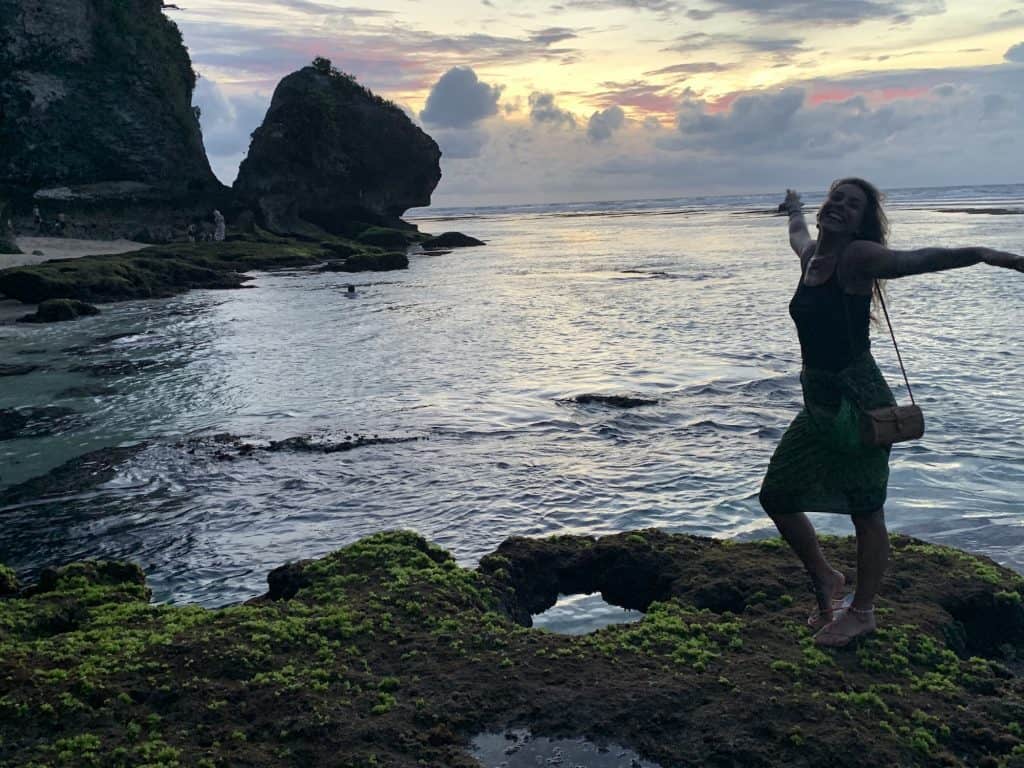
Everybody says the best time to go to Bali is after April, when the west monsoon (which starts in October) is over. However we stayed there for two weeks in the second half of February and it was the best choice. Although it is the rainy season, it doesn’t rain enough to spoil the holidays. It rains like one or two hours and stops. You go to the beach, dive or go see the temples or rice paddies. The climate didn’t affect our trip negatively in any way.
The second reason why February is a good time to go to Bali is because it is slightly less hot. The average temperature is around 30ºC with 85% humidity, which is totally summer for me.
The third reason that makes October-April the best to go to Bali is because it has significantly less tourists. For us, some parts were already crowded in this low season, which means it should be unbearable in the high season.
SIM card and money exchange
We just landed in Denpasar and immediately bought an unlimited SIM card while still inside the airport. It cost us around 10€ for one month.
Our second stop before leaving the airport was to exchange some money. Pay attention to these tips:
- Do not exchange inside the airport. It has incredibly long queues.
- Exchange just outside the airport, on the way to the parking lot. The rates are the same and there are way less people.
Hiring a driver in Bali
We researched a lot before traveling and we were advised to hire a driver in Bali. The reason is that you’ll need a motorized means of transportation to get around as the public transportation is not very efficient and many attractions are out of the cities. One possibility is renting a scooter, which we initially thought of doing but then we dropped this idea. The other possibility is a car-rental, but the idea of driving in a totally different environment spook us a little. Then there are the private drivers that are very professional and also work as guides for an affordable rate.
We contacted Aryo, our first driver, through a Spanish Facebook group. He was recommended by someone in the group and we arranged all details before traveling. We didn’t pay anything in advance.
Aryo gave us all instructions to meet him in the airport and when we saw him, we immediately knew he was a great guy with a big smile. He took us to our hotel in Ubud and he was our driver and guide in strategic moments to do some sightseeing we couldn’t really do well by ourselves. We chose Ubud first because it is a must-see in Bali. Ubud is a mystical place with amazing waterfalls.
The transfer from Denpasar Airport to our hotel in Ubud cost 250,000 rupees (16€). You can check some transfer options here or other ways to leave Ngurah Rai Airport here.
What to do in Ubud
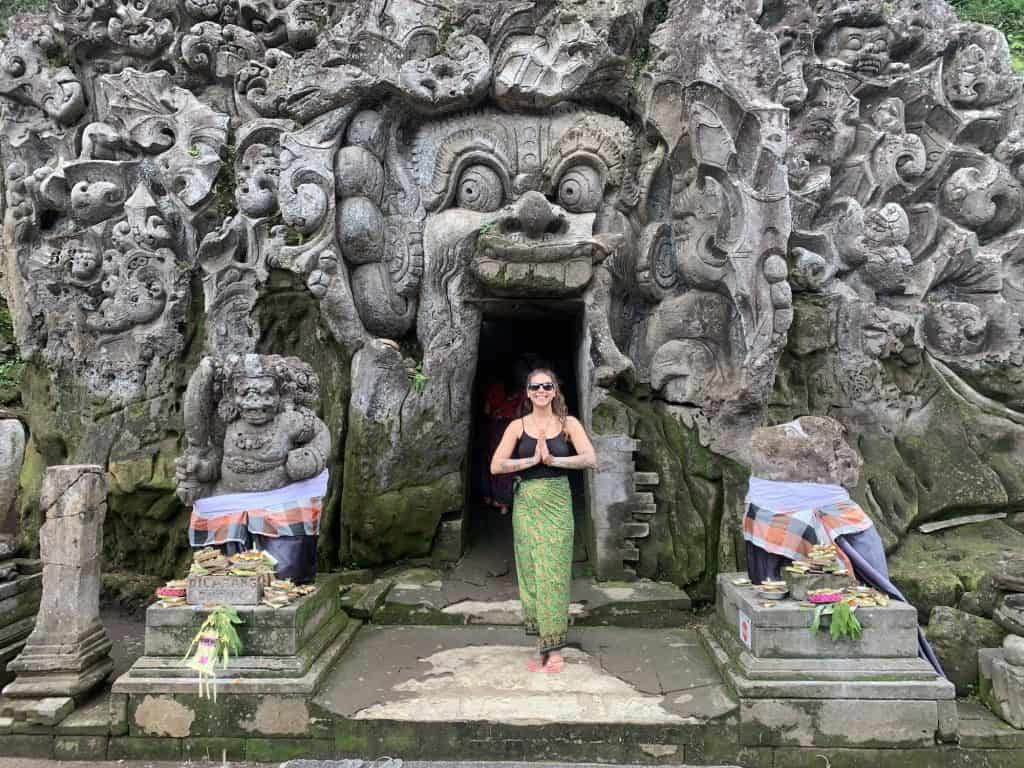
Our first hotel, in Ubud, was chosen on Booking. It was nothing special but in a central location. It cost us 12€/night. From there we could do some sightseeing just by walking around – and that is what we did. We went to the Ubud traditional art market and then the temples.
For the next two days we hired Aryo, our guide and driver, again to take us away from the city. With him we went to the Monkey Forest, a park and sanctuary that is the natural habitat of the Balinese long-tailed monkey. The entrance costs around 5€ and it is worth it. There are three temples there and more than 1,000 monkeys!
But what really makes Ubud so famous are the waterfalls, that are simply incredible! Attention that some of them are not free to enter (price list below).
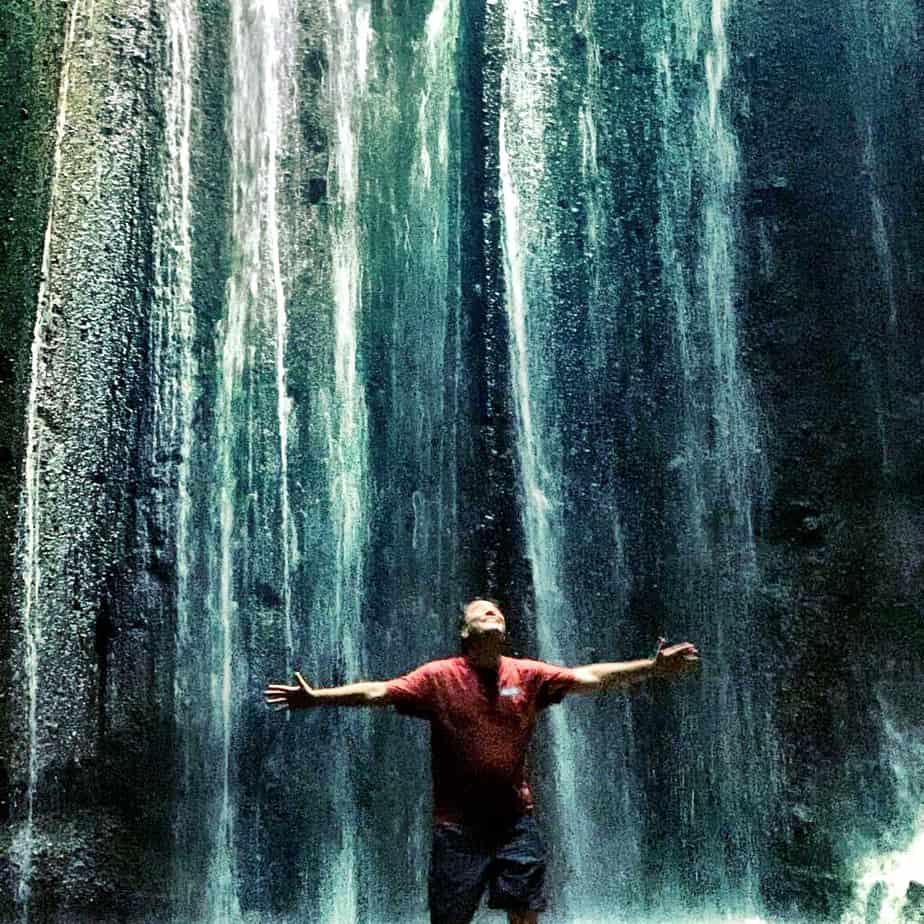
Our car cost 40€ per day and the activities list was long. We visited Tibumana, Tukad Cepung and Tegenungan waterfalls, Tirta Empul temple and a rice paddy. Agriculture is a very important part of their economy, as much as tourism, meaning that travelers should contribute with a donation to the locals when visiting plantations and paddies.
We also went to visit a farm where kopi luwak coffee is gathered and grinded. Have you ever heard of this? The most expensive and strange coffee in the world.
What is kopi luwak?
Unlike usual coffee, where seeds are cultivated and then harvested, kopi luwak is coffee beans defecated by civet cats. Yes, you read right.
Kopi means “coffee” in Bahasa Indonesian and Luwak means “Asian palm civet”, a mammal that is not a feline, that eats coffee beans and then defecates them. The feces get dry and are collected by farmers around the forest. Next step is to clean and grind them. This traditional way of production makes the kopi luwak extremely expensive – a pound could cost up to 600US$.
Instagrammable places
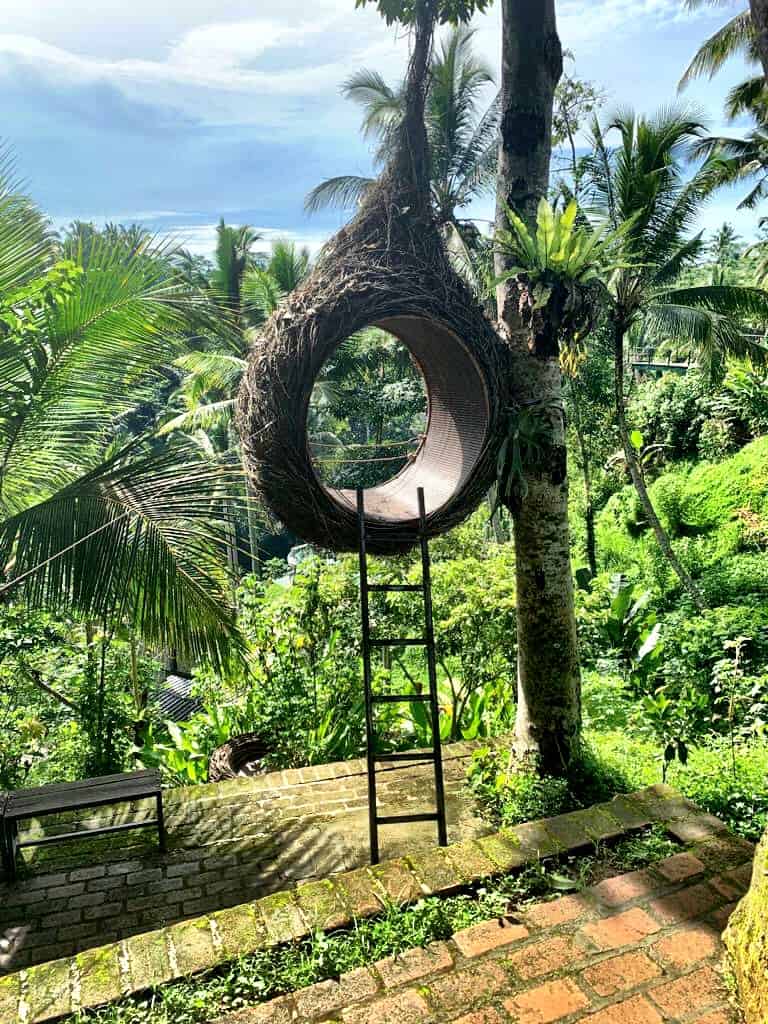
The kopi luwak farm we visited is all set for taking great pictures. It is a very instagrammable spot, where they set a stage for pictures and expect visitors to make the most out of it for social media. It’s a paid set, not expensive at all (but after all, we didn’t pay for taking pictures).
Another famous staged spot for pictures is known as the “Bali Swing” (30 minutes from the center of Ubud), where you rent a long glamorous dress and swing from an extreme height. It is a bit expensive though, around 25€, but, again, we preferred not to take a picture there.
There are some tours including the Bali Swing and other activities that might be interesting if you want to experience this super touristy attraction.
In any case, Bali is very beautiful and has amazing places to visit – sandy beaches, waterfalls, and temples are some of them.
Entrance prices for the most popular attractions in Ubud (per person, in euros)
- Monkey Forest: 5€
- Tibumana waterfall: Free entrance
- Tukad Cepung waterfall: 0.90 for adults and 0.60€ for children
- Tegenungan waterfall: 0.90 for adults and 0.60€ for children
- Bali Swing: 22.70€ plus an entrance fee 1.50€
- Tirta Empul Temple: 2.90€ for adults and 1.45€ for children
- Pura Dalem Puri Peliatan: 5€
- Pura Taman Saraswati: Free entrance
- Ubud Water Palace: Free entrance. Classic Balinese dance performance at 7:30pm costs less than 0.10€
Gili Islands, Lombok
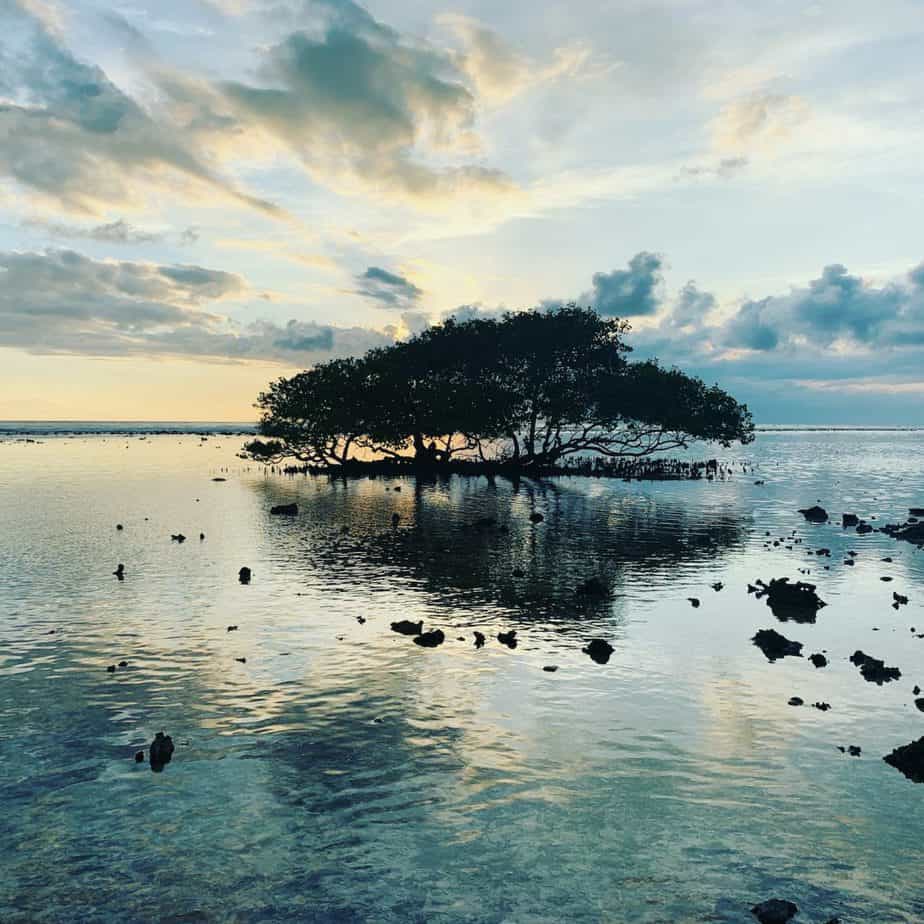
The Gili Islands is a group of three tiny islands (Gili Trawangan, Gili Meno, and Gili Air) known for their turquoise waters and breathtaking sunsets. They are 2-3 hours away from Bali. What many people maybe don’t know before going there is that the Gili Islands are not in Bali but in Lombok. You can hop between the three islands on a taxi boat.
Our next destination after Ubud was Gili Trawangan. We reached it on a 3-hour boat ride that cost us 30€/person.
However, if you are in Lombok, go to the Bangsal ferry port and get one of the boats leaving for Gili Trawangan. The public boat costs less than 1€ and leaves when there are 40 people ready to go. The ride takes 30 minutes. The speedboat costs 5€ and gets there in 15 minutes. It leaves every hour, on the hour.
A second option is to book a tour.
Gili Trawangan is a super hippie island, with no cars, that welcomes many travelers especially for diving and snorkeling. We went there to dive and to see the famous underwater statues plus its amazing coral reefs and white sandy beaches.
Each activity in Gili Trawangan cost us around 20€ per person. One of them was to go around the three islands with a stop to dive with turtles. Bali is pure paradise for divers. A complete diving activity, with a cylinder, costs only 60€ or even cheaper.
There are no cars in Gili Trawangan, so bikes and horse-chariots are the only means of transportation. We never took the chariots because we were heartbroken by the way the horses were treated. They don’t rest anytime in the day or night. So we decided to know the island on foot or by bike. We rode the whole island in less than an hour.
Most of the activities on Gili Islands are related to the sea, like scuba-diving, snorkelling or sun-bathing. If you are a nature’s lover, in Gili Meno there is the Bolong’s Turtle Sanctuary, where you can visit and “help release” baby turtles into the sea (if the day matches, of course). It costs around 6€ (donation).
Something that we weren’t expecting is that they sell magic mushroom juices everywhere in Gili Trawangan. It really surprised us. A “magic juice” bottle costs around 12€. However, drugs are totally forbidden in Indonesia and can get foreigners into a big trouble.
In Bali, Gili and everywhere they have an exquisite taste for bars and restaurants. They are trendy, a bit posh even, they all have a kind of Ibiza touch. And also many of them have a romantic touch, with hearts shaped everywhere. It’s a good place to go for a honeymoon.
Where to stay in Gili Trawangan
There is a wide range of accommodation options in Gili Trawangan, like hostels, hotels, resorts, bungalows or private villas. Compared to European prices, they are very cheap. Travelers can stay in very nice accommodations from only 15€ or 20€ per night.
We stayed in an amazing beach-front hotel for four nights. It was a resort with all the luxury and we paid 20€/night. It is an affordable tropical paradise.
Nusa Penida, a breathtaking island
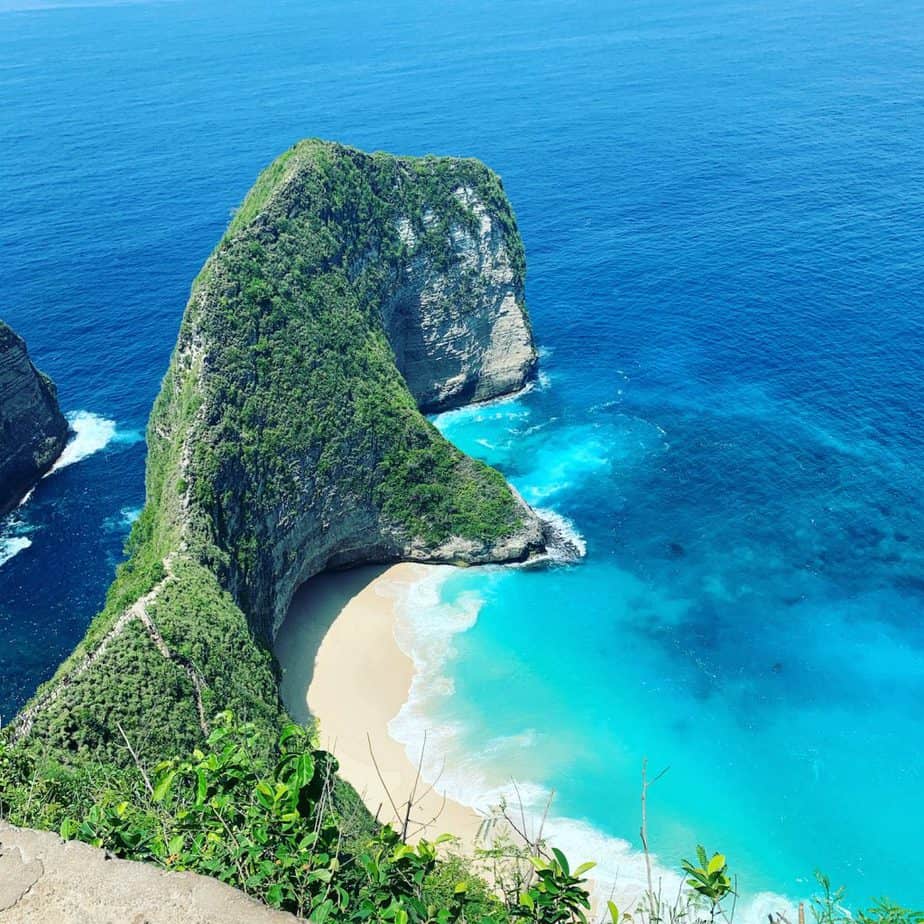
Our next stop after Gili Trawangan was Nusa Penida, another famous island and only 40-minute away from Bali. Generally people know Nusa Penida on a day-trip, but we decided to stay there for two days. This time we chose a small cheap hotel, paying 6€ per night. It was more than enough because our intention was to explore Nusa Penida the most we could.
You can’t do much in Nusa Penida without a car or motorcycle. Do not expect much of an infrastructure although there is a growing wave of tourists year after year. We hired a car and a driver-guide to show us all the beauty and paid 35€ per day. It is critical that the car has air-conditioning because even traveling out of the summertime, it was already very hot. It is also important to have as a driver someone that knows the area well because roads are winding, dangerous and in very bad shape.
Iconic attractions in Nusa Penida
Probably the most iconic place in Nusa Penida is Kelingking Beach. It is a mountain shaped like a T-Rex and down there a paradisiac cove with white fine sand and turquoise waters welcome the visitors. As in many places in Bali, there was a queue of people there to take pictures, but most of them did not want to go down. I don’t blame them. Going down means a challenging 30-min to 1-hour trekking with appropriate shoes (no slippers, please). Returning all the way up requires a strong heart. In total, the whole way down and up may easily take around 2 hours. As all the beaches in coves in Nusa Penida, it is a virgin spot, meaning visitors should bring their own food and water.
After knowing Nusa Penida, we decided to stop at Crystal Bay and have lunch there. It is a precious beach (no mountain to go up or down) with palm trees, fine sand and crystal waters for snorkeling.
We also went to Angel’s Billabong, a very peculiar spot in Nusa Penida. It is a sea pool formed between the rocks and that changes according to the tides. If the tide is low, you can walk on its formations, swim and even see manta rays. If the tide is high, there will be waves and it is dangerous to enter the water. So the visitor experiences a very different pool if going there in high-tide or low-tide time. Check the tide before and visit it in the low-tide.
Just a few minutes walking from Angel’s Billabong is Broken Beach, a small cove with an arch that allows the sea to come in and out. Unfortunately there is no way to go into the water, but it is another one of those spots for incredible pictures.
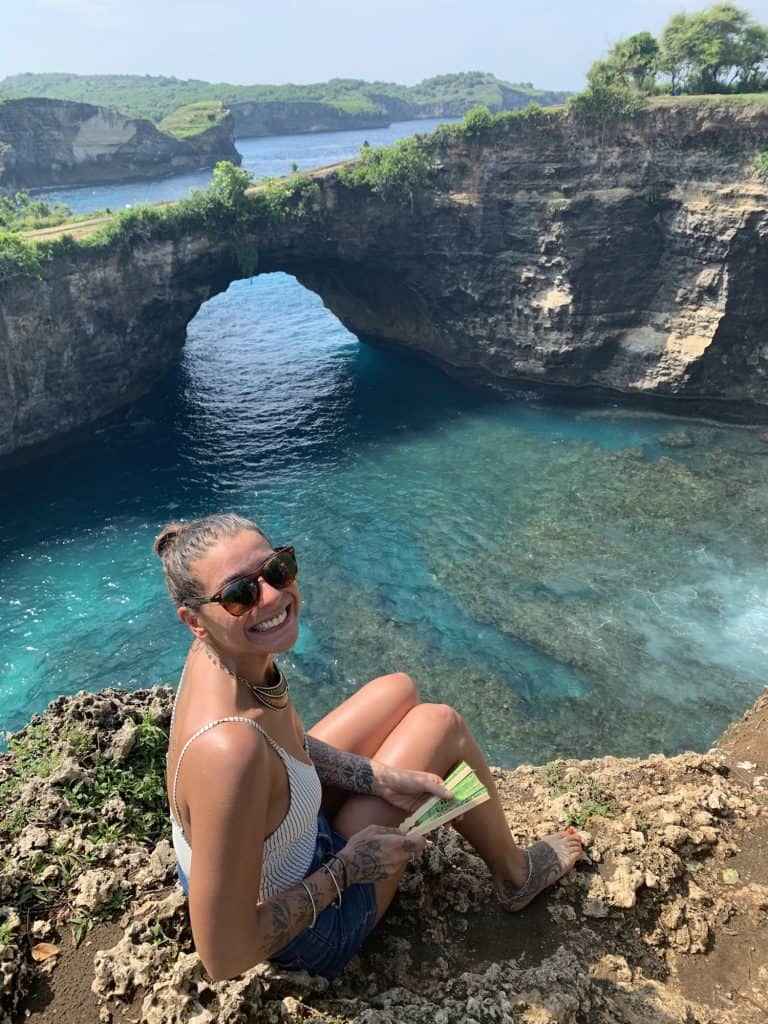
Uluwatu, a surfers’ paradise
From Nusa Penida we then headed to Uluwatu, a beach in the South of Bali. Aryo, our first guide, took us from the port to the hotel. This time we chose Blue Point Villa Spa, the most luxurious hotel we had on the trip. It cost us around 45€ per night.
Uluwatu is surfers’ paradise… just as all Bali! It is a famous spot for surfing good waves. We went there to enjoy the beach and shopping. A trendy beach there is called Seminyak. Regarding shopping, if you hear the locals, you can buy very nice goods for excellent prices. Aryo took us shopping and that’s how we brought a few extra kilos of clothes and decoration in our suitcase.
Bikes, the easiest way to get around in Bali
Bali is one of the Lesser Sunda Islands but it is not so small. The island of Bali is 5.636 square kilometers and the best way to get around in the cities is by motorcycle.
If you live in Bali, you can use two apps called GrabBike and Go Jack. They are on-demand ride-hailing motorcycle apps, just like Uber is for cars. A bike ride with them is super cheap, so I got excited and downloaded Grab. However, travelers can’t hire them in Ubud and Uluwatu; only locals can do that.
The price difference between the apps and the drivers is huge. The local drivers charge travelers much more while the apps drivers serve the residents. As for the price, while Grab charges around 2€ per day, a local driver charges 5€.
Another option is to rent a bike and drive it yourself. Expect something around 4€ per day.
Bali in a nutshell
Visa
Travelers of 169 countries are visa-free if staying less than 30 days and for tourism purposes. However, visitors should have a return flight ticket, a valid passport (6 months) and at least 2 blank pages in the passport when entering the country. For stays between 30-60 days, a visa can be requested upon arrival (35US$ to be paid in cash). For stays from 60 days on, it is mandatory to request a visa in the Indonesian Embassy in the traveler’s country.
Traffic
Awful, chaotic. This is why we preferred not to rent a scooter and preferred to hire a car driver.
Poverty
It is more or less like in Thailand – not much of extreme poverty. We didn’t see homeless people or beggars.
Safety
We never felt unsafe in Bali. People are nice and polite, just like in Thailand.
Bargaining
This is annoying but the first price given is always inflated. So you have to bargain. It was like that everywhere. The first price given, you reduce it to half and bargain.
Food
Expect lots of rice and fish with a spicy flavor. The most known dish is Nasi Goreng, fried rice with chicken, fish, or beef. You can also have lots of coconut water and açaí. A full plate in a very simple place can cost as little as 5€.
Besides paying not much food, in case you are short on budget, you can also find trendy and cozy restaurants nearly everywhere tourists are. For instance, in Ubud there are plenty of nice restaurants to eat out.
Money
The national currency is Indonese Rupiah and we almost felt like millionaires: 1 million rupees is around 60€. We used Revolut as our payment card and also to withdraw some cash. It was accepted everywhere in Bali and it costs less than other cards. I withdrew 500€ with it. We highly recommend it.
English
People speak basic English, with a few exceptions (our guide spoke it very well). You need to be patient and speak slowly.
In one sentence…
It’s a paradise, but overtourism is killing it. It has to be protected otherwise it will end soon. We even saw plastics in the ocean. But our general feeling is that it is a beautiful place with lovely people.
*** Edson and Maíra Eiras are Brazilian expats living in Spain.